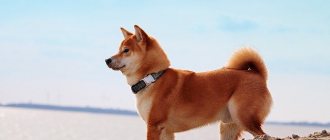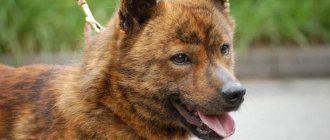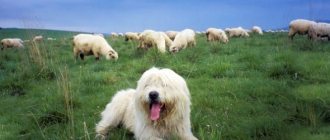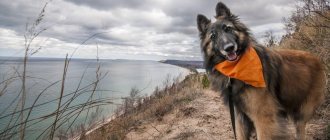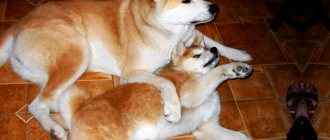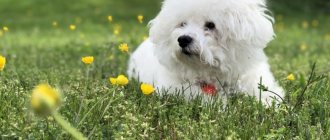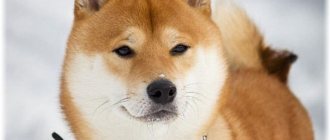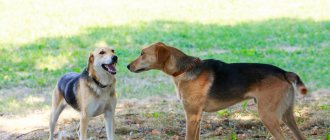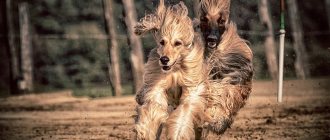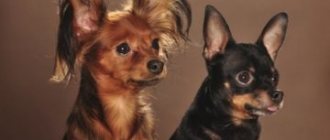Other names: Kishu-inu, Kishu-ken
Kishu Inu is a hunting dog breed that is white in color and has pointed ears. Distinctive features of this breed are triangular erect ears and a tail bent into a ring. Externally, Kishu resembles another Japanese breed - Shikoku.
History of the Kishu breed
Kishu dogs first appeared on the island of Hokkaidu in the mountainous region of Kishu Province. The exact homeland of the breed is Wakayama Prefecture. Thus, Kishu dogs are indigenous.
The breed has been known since the Middle Ages. In those days, kisyu were actively used in hunting various animals, including wild boars and deer. Thus, even the mountain climate allowed the dogs to acquire a strong character and real resistance to various life circumstances. The natural conditions in which the breed began to develop determined the appearance of high-quality warm wool, which is protection from cold days and frosty nights.
Kishu is a native dog that originated in Japan. True Japanese are confident that the breed can be associated with a true concept of the spirit of the entire people, a devoted attitude, a readiness for brave deeds and true devotion. Kishu are amazing dogs, so it is not surprising that the Japanese compare themselves to them.
Since ancient times, there has been a special attitude towards the Japanese Kishu breed. Puppies should live in a comfortable home and be as close to people as possible. Adult dogs should not live in the backyard, as such conditions will immediately humiliate any representative of the kitty. Every pet should feel that it remains needed and important to its owners.
Choosing a puppy
Even in Japan itself, Kishu is considered a rare and not very widespread breed . In other countries, there are only a few kennels that professionally breed these dogs. In our country, Kishu Inus are extremely rare, and it is very difficult to buy a puppy.
It is difficult to buy kitty puppies
The baby Kishu can be confused with other Japanese dogs, our huskies and simply similar outbred dogs. Only highly specialized dog handlers, of whom there are only a few, will be able to understand all the intricacies, and they all live in Japan. Therefore, you need to purchase a puppy exclusively from a reliable, trusted breeder with good recommendations and positive reviews. He must provide the necessary package of documents (pedigree up to the fifth generation, puppy card, veterinary book with notes on vaccinations, hunting diplomas of parents, etc.), which will confirm the thoroughbred of the animal.
In Russia, Kisyu puppies can be purchased in nurseries: “Nord Fantasy”, SNOW GALAXY, “Kryazh Yakutii”. The price for Japanese Kishu Inu dog puppies starts from 100 thousand rubles.
Video: Kishu Inu puppy
General characteristics of Kishu
Kishu is a northern sled dog related to the primitive Spitz. At the same time, one can note the amazing devotion of each representative of the breed. It is important to note that kisyu is actively used for hunting, since the peculiarities of living conditions in the northern region contributed to the development of a hardened and persistent character of the pet.
The color can be different, but in any case the kishu is amazingly beautiful:
- White.
- Brindle.
- Sesame.
- Ginger.
Weight and height are determined by the gender of the pet. In this case, it is not the dog’s living conditions that play a role. Weight, as well as height, is always determined at the genetic level for each representative of the breed.
Dimensions are always based on the withers:
- Males - up to 45 centimeters.
- Bitches - up to 40 centimeters.
Another important physical criterion is the dog’s weight. At the same time, males can weigh up to 25 kilograms, and females – up to 20 kilograms. Kishu in most cases lives about 14 – 15 years . At the same time, the exact life expectancy is determined largely by the living conditions of the pet, which requires high-quality and constant care.
Tosa Inu (Japanese Fighting Dog, Toza, Sumo Dog)
- The official name is Tosa Inu.
- FCI classification – group 2, section 2, standard No. 260.
- Origin and patronage - Japan.
- Dimensions: 55–60 cm or more.
Japan, like England, became famous for the bloody sport of dog fighting. With the beginning of the export of dogs from Japan and into its territory, owners of fighting dogs were disappointed to find that Japanese fighters were smaller and weaker than English ones. Indeed, who could compare with the power of the Old English Mastiff or Bulldog.
The damaged honor of the Japanese was restored after the fearless Tosa Inu were brought out. By mating European Molossians with Japanese dogs, an invincible giant was obtained, ready to fight to the death. Today, Tosa Inu is the property of Japan; it is almost impossible to take a purebred puppy out of the country. In the homeland of these giants, dog fighting is still carried out under a legal banner, and the participation of Tosa Inu in them is an unshakable tradition.
Samurai dogs need serious, step-by-step and gentle training. At the same time, the owner must establish a leadership position in the pack without humiliating the pet. Tosa Inu cannot be called extremely active, but the dog needs daily exercise. Since the breed is large, normal training and quality nutrition in the first year of life play a very important role in the development of the puppy.
Standard
The Japanese Kishu dog breed has certain standards:
- Height – 43 – 56 centimeters.
- Weight – 20 – 27 kilograms.
- The body is small.
- The wool is characterized by its minimum length, stiffness, and straight structure.
- A dense undercoat is provided, which guarantees maximum protection for the dog even in severe frosts.
- Standard color is white. It is important to note that the blood of Kishu flows from other breeds, namely Kai, Shikoku Ainu, so the coat can be brindle or beige. Although there are other coat colors, only white meets the standard.
- The tail and cheeks have longer fur;
- The shape of the head is wide and wedge-shaped.
- The shape of the erect ears is triangular.
- The bite has a scissor-shaped bite. In this case, the upper and lower incisors close together, resulting in a zigzag without the slightest gap.
- Kishu belongs to the 5th group of dog breeds.
Japanese dogs
In the register of Nippo, the cynological organization of Japan, there are 6 breeds that are recognized by the association. We offer a description of native Japanese dogs with photographs of pets. They are all similar in appearance, the differences being only in the height at the withers and color.
Akita Inu (Japanese Akita)
One of the largest representatives. Few people know that this teddy and playful bear is actually a hunting dog that was used to hunt wild boars. According to standards, the height at the withers is 70 cm, weight can reach up to 55 kg. The International Cynological Federation FCI allows three colors:
- red with a white mask on the face, a white spot on the chest and paws;
- snow-white;
- brindle with white.
Akita will protect all family members, but solely on its own initiative. This is a devoted dog, faithful to one owner. Despite the desire for leadership, he is easy to train.
The price of a puppy is from 30,000 rubles.
Shiba Inu
Bred on the island of Honshu and recognized as a national treasure of Japan. One of the smallest Asian dogs with excellent hunting qualities. Valued for hunting wild birds (pheasants, ducks). Black and tan, red, snow white and so-called “sesame” colors are recognized.
Shiba needs early socialization. It is believed that if a puppy is not accustomed to people before it reaches three weeks of age, then it will never get used to people in the future. Even well-socialized individuals, despite their devotion to their owner, from time to time show that they can cope just fine without him. Smart, cunning, willful. Alert and curious. They are playful and always try to take part in fun activities with children. However, they prefer to watch the games of other dogs from the sidelines.
You can buy a puppy “for yourself” from 40,000 to 50,000 rubles, for breeding and exhibitions – from 75,000 rubles.
Kai (kai-inu, tora, ryuku)
Originally Japanese, rare breed. Classified as a subgroup of Asian Spitz. Entered into the FCI register in 1982. Bred in the northern province of Yambaru for hunting wild boars. The height at the withers reaches a maximum of 55 cm for males and 52 cm for females.
The kaya has a coarse, double coat with a soft and dense undercoat. Puppies are born monochromatic, the color appears later. The name means "tiger dog" and the photographs show that the dog really does look like a tiger. The color can be red brindle or black brindle (genetically dominant).
Tora is a calm, clean dog, an excellent companion, attached to only one family member. It has excellent security and protective qualities. Strong-willed, capable of making independent decisions in emergency situations. If threatened, he will defend the “leader” even at the cost of his life.
“Working” hunting dogs require early socialization and training. Active, need constant physical activity.
Shikoku (kochi-inu or koti-ken)
A rare breed even in its historical homeland. This ferocious-looking dog, which resembles a wolf in appearance, was bred in the Middle Ages to hunt wild boars and deer. Jumping, fast, moves well in the mountains, and is known for its good guard qualities. In 1937, the canine organization Nippo recognized the breed as a natural monument of Japan, and in 1982 the FCI included Shikoku in the international register.
The character is wayward and can often ignore commands, so the Kochi Inu needs an experienced owner with strong leadership qualities. Easy to train, attentive, efficient.
Important! Shikoku need a fenced area, otherwise they can escape. Can't stand being tied up
Kishu (kishu, kishu-inu, kishu-ken)
A primitive hunting dog, used to hunt wild boar. It has a typical “Japanese” exterior: a tightly curled donut tail, a wedge-shaped head, erect ears.
Interesting: local residents believe that Kishu-ken descended from wolves. Once upon a time, a hunter found a wounded she-wolf in the forest and left her, asking for one of her cubs in return. The she-wolf kept her promise and gave the man a wolf cub. It was this wolf cub that became the progenitor of all Kishu Inu.
Hokkaido (Ainu-ken or Seta)
The indigenous people of Hokkaido bred them to hunt bears. During the Second World War, Ainu-ken were trained and used as scout dogs. Seth determined the location of the enemy camp and transmitted information to headquarters.
They have a very strong hunting instinct; they can fight animals ten times their own weight. Thanks to their hard, thick coat, they are perfectly adapted to snowy winters.
Noble, intelligent and hardy animals. They are prone to destructive behavior, so they need constant physical activity.
General description of the Kishu breed
Kishu is an intelligent dog that is ready to show decent hunting abilities. At the same time, representatives of this breed are initially distinguished by their friendly character. The main character traits contribute to the fact that a pet can be a good protector for housing and household members, ready to become a faithful friend.
Despite the fact that Kishu is distinguished by special patience in many circumstances and amazing endurance, friendliness and affability, many strangers note distrust. It is important to note that such distrust is due only to the fact that by nature representatives of the Japanese Kishu breed must perform protective tasks at a decent level.
Kishu requires long, long walks. At the same time, a dog can be successfully kept even in an ordinary city apartment.
Owner reviews
Most owners of these dogs note the independence of their animal. It tolerates loneliness calmly and does not require a lot of time for itself. So they are ideal for a single person who needs to leave home for work or study. But this does not mean that kitties do not love their owners; on the contrary, they are very loyal and loving dogs.
Also, many potential owners will be pleased with the fact that these animals are very laconic . They rarely voice and bark only for serious reasons.
Kishu character
Kishu is a talented dog breed . This is proven by the fact that many Kishu representatives have not only decent hunting qualities. Since ancient times, the best representatives of the breed can delight with their ability to fish and their ability to work as a shepherd.
The character can be somewhat rude and cold. At the same time, aggression cannot be felt. The coldness in character is determined by the history of the breed and its purpose.
Training is not that easy to do. This is due to indifference, arrogance and self-confidence, a developed hunting instinct. At the same time, the possibility of achieving better results in training is guaranteed. The most basic goal is to demonstrate persistence in training and a respectful attitude. Any disrespect causes complete failure in raising a kitty.
Pets can be loyal and protective towards their owners. But given the Nordic nature of kishu, it is extremely important to show tact. Kishu are willing to play with children as long as cuddling is not allowed. Respect is the basis of a good relationship with Kishu dogs.
Interesting Facts
There are many legends about the Akita Inu. Most of them are based on real moments from the history of the breed.
Here are some fun facts:
- In ancient Japan, the Akita Inu was believed to bring good luck. The local nobility had a separate ceremony for communicating with pets;
- The shogun (leader) of Akita Prefecture issued a special decree according to which a man was executed for killing a dog;
- in the USA, representatives of the breed are more often used as bodyguards, in Japan they are trained to participate in rescue operations;
- Hachiko is the real-life dog of a Tokyo University professor. The nickname translated from Japanese means “eight” or “eighth”. The owner named him so unusually, because this was the name of his pet.
In 1934, a monument to the faithful dog was erected in Tokyo. During the Second World War, the monument was melted down due to a shortage of metal, and in 1948 it was restored again. It still stands today in the square near the railway station.
Care and maintenance
Kishu require special care. What principles should the content be based on?
- The coat needs to be cleaned and combed regularly. Thorough cleaning of the coat, which involves the use of a brush, is required after walks. Frequent washing is not recommended, as otherwise there is a risk of skin irritation. It is best to clean the fur with a brush and wipe it with a damp towel. The presence of dead hairs is not allowed.
- Ears need good cleaning. Otherwise, there is a risk of developing ear diseases, which can even lead to deafness.
- A mandatory procedure is trimming the claws using special scissors. Trimming nails too short can damage blood vessels.
- Physical activity should be regular. At the same time, it is recommended to observe moderation.
Appearance of a Shiba Inu
The Shiba Inu has a strong bone structure, is harmoniously built, and the overall constitution reflects the endurance and massiveness of its ancestors, who had to spend many hours hunting. Representatives of the breed have strong paws of medium size, a triangular head, similar in shape and location of the eyes to a fox.
Dimensions
Males at the withers range from 38-41 cm, weight ranges from 9 to 14 kg. Females are smaller, the height of individuals is 35-38 cm, weight from 8 to 13 kg. The Shiba Inu is a well-balanced, lean dog with a tail curled over the back.
Head
The forehead is flat, often with a longitudinal line, the muzzle is thick at the base, becomes sharper closer to the nose, and resembles a fox in shape and color. The Shiba Inu's eyes are small, close-set, slightly slanted, and usually brown. Prick ears are a distinctive feature of the Shiba; they are dense to the touch, slightly turned forward, and have a characteristic triangular shape. The animals have a strong muscular neck, emphasizing the solidity of the figure. Characterized by a scissor bite and solid, good teeth. The nose is straight-backed and predominantly black.
Frame
The dog is massive, prone to long-term stress, has good health and endurance. The straight and strong back ends in a muscular lower back. The breed is characterized by a moderately wide chest, medium curve of the ribs, and a lean belly. All parts of the Shiba Inu's body are harmonious in size, individuals have a strong and lively constitution.
Limbs
Shiba Inu Paws
Shiba Inu paws are proportional to the body, fairly dense and large, of medium length. In the forelimbs, the shoulder blades have a moderate slope, the elbows are located closer to the body, oriented strictly back. An active lifestyle has clearly affected the hind legs; they have developed muscles, elongated hips and short legs. The high mobility of the Shiba Inu is explained by the massive hock joints; the softness of the forms is maintained by moderately expressed angles of the joints. The paws are distinguished by good elasticity, the claws are predominantly dark in color, the toes are tightly compressed and protrude in relief.
Tail
The tail is one of the important criteria of the Shiba Inu breed. Curled into a well-defined ring, set high, the length can reach the hock joint, covered with dense hair, quite thick.
Color
There are three main types of Shiba Inu colors: red, zone or sesame, black and tan, silver or red. A mandatory component for participation in exhibitions is urajiro - a special pattern that creates lighter fur in the area of the cheekbones, neck, lower chest, and abdomen. Lighter areas should also be located on the inside of the paws and the underside of the tail.
Shiba Inu in profile
The gradation of sesame color is interesting; there are three main directions:
- red sesame (or sesame) is a mixture of red and black hair, usually red hair with a black edge;
- black sesame – black hair predominates over a small amount of light hairs;
- sesame (sesame): equal number of black and white hairs.
The breed is considered defective if its color, sand and white shades are too light. The most desirable color is bright red, deep and rich.
Black Shiba Inu
Wool
Let `s play!
Dense and two-layered coat is a real decoration of the Shiba Inu. The soft and thick undercoat gives the dog a special charm. The second layer is represented by hard guard hair, it is straight and significantly raised above the undercoat.
Disqualifying defects
Particular attention is paid to the color of the Shiba Inu; individuals of light sand color, cream and white are not allowed for exhibition. Also, for exhibition specimens, a urazhiro is required.
A disqualifying factor is drooping ears; this characteristic is one of the leading in identifying the breed. The shape and size of the tail are important: its insufficient length will not allow the pet to participate in competitions. Defects also include its sagging and the absence of a characteristic bending ring.
Compliance with the size standard is important: small-sized males and small-sized females are not allowed to participate in exhibitions.
Much attention is paid to the oral cavity, the absence of a large number of teeth will cause disqualification, and the dog should not have an underbite or an overbite. Among the behavioral characteristics of the Shiba Inu, cowardice and aggressiveness are unacceptable.
Health (possible diseases)
Negative manifestations that may indicate health problems:
- Insufficient sexual dimorphism.
- Excessively long fur.
- Aggressiveness or cowardice, timidity.
- Malocclusion.
- Irregular tail shape: drooping or short.
- Excessively floppy ears.
The most common diseases of Kishu:
- Arthritis.
- Hip dysplasia.
- Dislocation of the kneecap.
- Gastric torsion.
Feeding
Kishu has an unpretentious attitude towards food . Despite this, many owners take care of their pets and try to properly organize their diet. Various nutritious feeds are an ideal option, because they are distinguished by the balance of all valuable substances, components and minerals.
Only in the first months of life is it recommended to focus on low-fat fermented milk products, high-quality boiled meat and vegetables. At an older age, it is allowed to include food in the diet taking into account the activity of dogs, semi-cooked and raw meat, dietary and nutritious cereals.
The diet should be aimed at keeping dogs active.
Japanese Chin
We should start the review with the most charming Japanese dog, which has long taken a place in the hearts of a large number of people. We are talking about the Japanese Chin. This little dog is so cute, active and playful that it simply has no equal among miniature pets. Only the Pekingese could compete with her, but his short legs and heavy landing simply do not allow him to catch up with the perky, self-confident and light little one.
The Japanese Chin is filled with a sense of self-importance and wants to be the center of everyone's attention, so it becomes very upset if its own attention is rejected. For more than 1000 years, chins belonged only to the imperial family, being royal favorites. One of the emperors even ordered them to be worshiped, declaring the dogs sacred. They had their own servants and doctors, and only members of the imperial family could own them. Especially miniature specimens were kept in cages, in a suspended state. A pair of Chins was given to Queen Victoria in 1853, which influenced the further development of the breed.
The Japanese Chin is unusually graceful, with a proud posture and luxurious coat. The coat color can be white with either black spots or red markings. The more distinct and brighter the red color, the better it is considered. The spots on the head and ears should be placed symmetrically relative to each other. Some believe that chins are descendants of a lion and a butterfly: they really look like a lion with their muzzles and are mobile, fluttering like butterflies.
